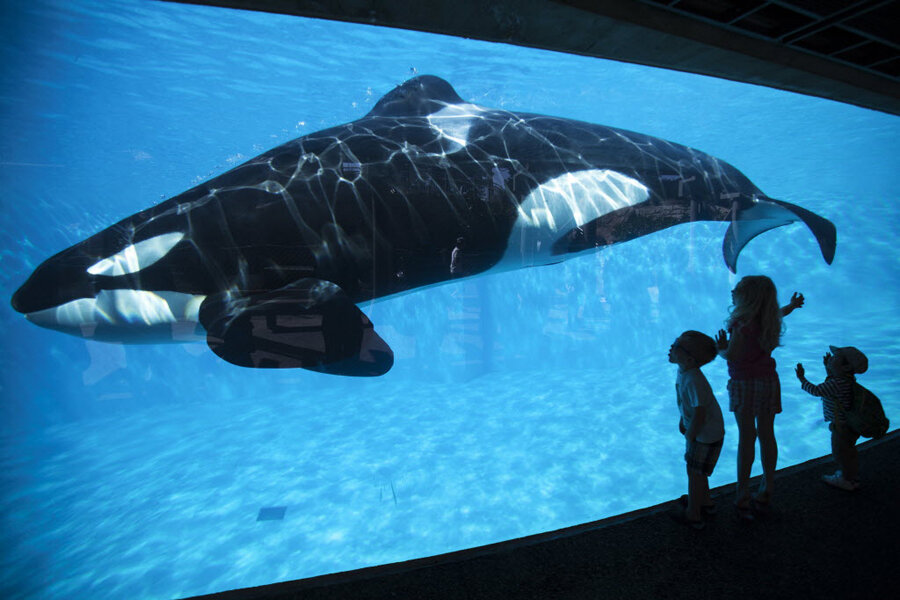SeaWorld debate flares: Are families souring on orca shows?
Loading...
| Los Angeles
When the Stierle family made plans for a trip to San Diego recently, it made a conscious decision not to go to SeaWorld. Watching the 2013 documentary, “Blackfish” – which alleged that the park mistreats its orca whales – turned the family against park’s signature shows.
“Even the boys said, ‘This isn’t right to keep huge creatures in very small spaces just to entertain the public,’ ” Mr. Stierle says.
But for Sanjay Agarwal, SeaWorld is the reason his 11-year-old daughter wants to become a marine biologist. Despite being anti-circus, she was captivated by what she saw on a backstage tour.
“We paid $300 to go backstage and see how the [whales] were kept and fed,” Mr. Agarwal says. “Seeing it all up close is what was the secret for our daughter.”
The two viewpoints frame a growing debate over whether the large-animal shows at the heart of SeaWorld’s image are still seen as suitable fare by American families.
This week, SeaWorld has launched an ad campaign in major newspapers across the country and in California and Florida – where its parks are located – to combat what it says are gross distortions of how it treats sea animals.
But criticism continues to build, with John Hargrove, an orca trainer for 14 years, claiming in a new book, “Beneath the Surface,” that the conditions in which Sea World keeps orcas are inhumane and drives them to become aggressive.
Facing similar criticism over its treatment of elephants, Ringling Bros. and Barnum & Bailey has announced a plan to retire its elephants by 2018.
In many respects, parents hold the final vote on the issue. SeaWorld's revenue dropped 3 percent this year compared with last, and its chief executive has resigned. The company has announced plans to build larger environments for its orcas.
For Sheri Muntean of Anacortes, Wash., SeaWorld brings back “wonderful memories” of visits to see her grandparents in San Diego. But she says she would most likely not take her grandchildren there now.
“I believe it would be sponsoring human behavior that harms animals,” she writes in an e-mail.
The park’s new ad campaign, together with its plans to build larger environments for its orcas and its change in leadership, are attempts to restore public trust and maintain legitimacy in an environment where Americans have become increasingly sensitive to treatment of animals.
The “Blackfish” documentary alleges that keeping the enormous and intensely social sea mammals in such confined spaces amounts to cruelty. It includes the story of veteran orca trainer Dawn Brancheau, who in 2010 was dragged into the water and killed by a whale at the SeaWorld Park in Orlando, Fla.
In an effort to address “claims that have been leveled against us head on,” the park encourages the public to pose questions about the company’s practices on the new website AskSeaWorld.com, according to an official company statement. “The point is to reach people who will hear out SeaWorld’s stance.”
But the website has at times been overwhelmed by negative comments. The debate is an opportunity for families to have a discussion about issues of captivity for all creatures, says Catherine Doyle, director of science, research, and advocacy for the Performing Animal Welfare Society.
“Even if you think it is wrong to hold whales captive like this – as we do – it can still be a learning experience for a child to ask the question and to be shown what the choices are,” she says. “If parents are doing their job and telling them all the facts, kids are pretty smart in knowing when something is wrong.”
When Stierle and his wife, Suzanne, heard about the sterling reviews for “Blackfish,” they decided to watch it with their two boys, 13-year-old Tristan and 8-year-old Aidan.
“We made a conscious decision to not go to SeaWorld, even though we were in San Diego for vacation,” says Stierle, father of three.
Stierle says he doesn’t buy any of the arguments of SeaWorld’s new ad campaign. “They are just putting out a narrative to suit their own needs at the expense of these whales, and when I hear it, I turn into a bit of a ranter. They are trying to turn a buck in entertainment and calling it education and even my kids see through that as trying to justify bad behavior.”
Others agree. “I do not believe that any animal that thrives in family groups in the wild should be removed from the wild,” writes Jolee Walker of Mason, Wis., in an e-mail.
But for the Argawal family, the opportunity to see orca whales up close potentially sparked a career dedicated to the service and care of animals – a point that SeaWorld often makes in its own defense.
“When she saw this huge whale make a splash and jump and swim she was totally taken with the whole thing,” he says. “It’s one thing to see a fish in an aquarium and quite another to see [whales] jumping in a football-field-sized pool.”





